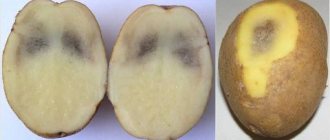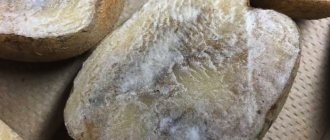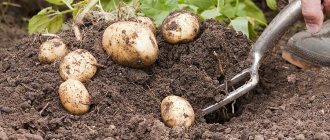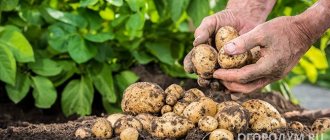Potato rot: why do potatoes rot during storage, and how to avoid it?
Despite the fact that potatoes are on sale in the markets all year round, you want your own - incredibly tasty, boiled and environmentally friendly potatoes. But often home-grown potatoes cannot be preserved until spring. After the New Year holidays, increased “spoilage” of tubers begins, an unpleasant odor appears in the storage facility and even (as they write in the newspapers) an explosive situation when gas accumulates in a closed room. What causes tuber rotting, and how to avoid it? Let's understand the reasons and develop a scheme for preserving the harvest of our favorite potatoes.
Why do potatoes rot during storage and how to avoid it.
Late blight of potatoes
Late blight is one of the most dangerous fungal diseases. The fungus infects the crop during the growing season (it can destroy up to 70% of the crop in a short period) and is transported with the tubers to storage areas.
Late blight of potato tubers.
Hard gray spots appear on the surface of the tubers, clearly visible on the pulp when cutting the potato. With the growth of the mycelium, the tuber begins to rot.
Protection and control measures
If plants are damaged during the growing season, it is necessary to spray the potatoes with a 2% raster of Bordeaux mixture. If a complex infection is suspected (that is, several types of fungal diseases), biofungicides “Fitohit”, “Fitosporin-M”, “Planriz”, etc. are used.
Optimal storage conditions are good ventilation, absence of light, air humidity within 80-90%, air temperature no higher than +2...+3°C. For late blight to develop, high temperatures are required (+20…+24°C). Therefore, storing potatoes in residential areas with high temperatures is not recommended.
The best potato varieties resistant to late blight are: “Lasunok”, “Temp”, “Scarlet”, “Aspiya”, “Vestnik”, “Golubizna”, “Lugovskoy”, “Resource”, etc.
Why do potatoes rot in the basement?
Mold is a fungus that forms well-branched mycelia (vegetative bodies) without visible large fruiting bodies. Loose white, yellowish, black or other colors of plaque are fungal colonies. Reproduction occurs using spores. They can be constantly present in the cellar or basement, but active mold growth begins only when favorable conditions are created for their development.
The appearance of fungus on potatoes can be caused by the following reasons:
- supply and exhaust ventilation is either completely absent or does not work well;
- increased air humidity;
- condensation on the walls of the storage facility;
- poor air circulation in the room;
- wooden structural elements are infected with fungus and were not treated with antifungal drugs;
- there are rotting plant debris in the room;
- poor waterproofing and, as a result, groundwater seepage;
- early ripening varieties that are not suitable for long-term storage are stored;
- Unripe potatoes cannot be stored for long.
First of all, you should fight the cause that caused the appearance of mold colonies. Without correcting this deficiency, all methods of combating mold will be temporary, since the fungus will reappear in the cellar.
Fusarium (dry rot) of potatoes
Like late blight, it affects tops and tubers during the growing season. The rapid spread of the disease is facilitated by excessive soil moisture (long rains) at high temperatures.
Fusarium (dry rot).
During the growing season, external signs appear in the form of gray spots on the leaf surface, general wilting and drying of plants. The affected plant wilts literally in one day. A striking distinctive feature of a crop affected by fusarium is a blue-black ring on the cut of the stem (vessels clogged with fungal hyphae).
Tubers stored for storage become covered with a whitish coating, or the skin in places where gray-brown spots form wrinkles and becomes dry (without obvious reasons for violating the rules for storing products). The section shows dark voids filled with mycelium.
What to do if potatoes rot in the cellar, why this happens and how to prevent the problem
Quite often, vegetable growers are faced with the problem of potatoes rotting after harvesting. This occurs due to the development of pathogenic microorganisms. If planted, harvested and stored incorrectly, the harvest will be lost. Therefore, it is important to know what to do if potatoes rot in the cellar. We will talk about this in our article.
Reasons why potatoes rot
Harvesting vegetables in rainy or damp weather, inattention when inspecting the crop, digging too early or too late are the main causes of potato rot.
Important! To prevent rotting, the room is periodically ventilated.
In the cellar, vegetables quickly rot at high humidity, inappropriate temperature, poor ventilation, and storage in bags with low air permeability.
Diseases
Rotting is caused by some dangerous diseases: late blight, bacterial rot, black scab.
Late blight
The fungal disease appears as dark spots on the tubers. When cut, you can see that the black rot goes inside the potato.
Late blight occurs during the growing season, and is activated already in the cellar if the temperature exceeds the norm.
Basic control measures:
- potatoes are sorted, infected tubers are removed;
- normalize the temperature in the room;
- healthy vegetables are treated with biological products (for example, “Gamair”).
Potatoes are dug up only in sunny, dry weather and poured into boxes in a layer of about 1 m.
Wet bacterial rot
Tubers with this disease become covered within a couple of days with patches of gray mucus with a terrible smell. Temperatures above +20°C and humidity above 90% provoke the development of the disease.
To get rid of rot, do the following:
- the crop is sorted and rotten tubers are thrown away;
- normalize humidity and temperature in the cellar;
- diseased areas on vegetables are cut off, the cut area is treated with alcohol;
- The potatoes are inspected periodically.
Black scab
The fungal disease causes small black spots (sclerotia) and cracks on the tubers. Rhizoctonia does not affect the taste of vegetables and is usually associated with late harvest.
Attention! The scab is passed on to the next generation of the crop.
Disposal and prevention measures:
- tubers are sorted and damaged ones are thrown away;
- the crop is treated with Ditan M-45 (200 g per 5 liters of water, the solution is enough for 100 kg of potatoes);
- normalize storage conditions.
How to store potatoes in the basement
To ensure that the harvest is stored in the cellar for a long time, the following basic rules are followed:
- They begin to prepare the room about a month before planting vegetables: it is cleared of debris, inspected for cracks and holes, washed with soapy water, treated with a 10% solution of copper sulfate, dried well, and ventilated for several days. The cellar is additionally insulated from winter frosts, the floor is covered with lime to get rid of excess moisture.
- The potatoes are dried for 5–15 days after being cleared of soil, sorted, and infected, mechanically damaged and unsuitable for storage specimens are removed.
- Make sure that the temperature in the basement is within +2...+4°C, and the air humidity is about 90%.
Tubers are periodically inspected for the presence of suspicious spots and growths.
Important! Potatoes are sensitive to changes in the environment, so they are kept in wooden boxes or bins with felt cloth at the bottom, sealed containers or bags. Plastic bags and tight, airtight bags will not work.
How to process potatoes
Before placing vegetables cleared of soil in the cellar, they are treated with chalk or wood ash. Among the chemicals used are “Fitosporin”, “Anti-rot”, copper sulfate, and Bordeaux mixture.
All containers for vegetables are pre-disinfected with a solution of potassium permanganate.
Why do potatoes rot immediately after harvesting?
Immediately after harvest, the crop rots due to exposure to pathogenic fungi and bacteria. To prevent the problem, it is important not only to be attentive to the preparation of vegetables and storage space, but also to follow the agricultural practices of growing the crop:
- plants are planted at a temperature not exceeding +15°C;
- the soil must be fertile (it will be difficult for potatoes in clay soil);
- seed tubers are cultivated whole or in slices, which are dried in advance and rolled in ash;
- the area is regularly weeded to remove weeds;
- monitor the soil moisture level.
If the potato is already sick, proceed as follows:
- The harvest is sorted, rotten and damaged tubers are removed.
- Healthy specimens are treated with contact fungicide "Ditan M-45".
- Vegetables and cellar are well dried.
- If new fungal or bacterial formations appear on the potatoes, the procedures are repeated.
Why do potatoes become covered with white mold?
The appearance of mold is associated with improper storage conditions for vegetables.
Prevention measures:
- selection of varieties with strong immunity and high keeping quality;
- periodic ventilation of the cellar;
- humidity and temperature control;
- disinfection of tubers and premises;
- adding only mature vegetables;
- insulation of the basement from groundwater;
- regular inspection of tubers for the presence of suspicious formations.
If mold appears during storage, take the following measures:
- The harvest is removed from the room and kept under an ultraviolet lamp for 5-6 hours.
- The walls, ceilings and bottom of the cellar are cleaned with lime mortar.
- Infected tubers are thrown away.
- To reduce air humidity, place a container with slaked lime. The vegetables themselves are sprinkled with sawdust or wood ash.
Sometimes smoke bombs are used indoors.
Tips and tricks
When planting a crop, choose a variety suitable for long-term storage: Picasso, Asterix and others.
Potatoes are not kept with other vegetables except beets: they are laid out in 1-2 layers on the tubers to remove excess moisture.
To reduce the temperature in the cellar during spring warming, place several pre-frozen bottles of water.
Conclusion
When choosing the right variety, preparing the tubers and cellar, maintaining optimal temperature and humidity, the crop will not lose its quality until spring.
If the vegetables have already begun to rot or become moldy, they are sorted out, disinfected along with the room, and everything is dried well. Do not neglect the basic rules for growing and storing crops, and then the risk of problems will be minimal.
Why do potatoes rot in the cellar #why do potatoes rot in the cellar
Source: https://agronom.expert/posadka/ogorod/paslenovye/kartofel/chto-delat-esli-gniet-v-pogrebe.html
Protection and control measures
The level of harmfulness is very high. The mycotoxins of this disease persist not only on the crop, but also on processed products. They affect the human nervous system and cause the death of birds and animals. Tubers (like other products - flour, juices, jam, animal feed) affected by fusarium cannot be used for food.
During the growing season, plants are sprayed with a 1-2% solution of Bordeaux mixture, solutions of biofungicides (Fitosporin-M, Fitohit, Baktofit, Integral, Planriz).
Optimal storage conditions are the same as for protection against late blight. It is recommended to treat the tubers with “Fitosporin” when storing them (the biofungicide does not affect the health of humans and animals). Systematically sort the potatoes (carefully so as not to break the outer skin, as the infection quickly spreads to neighboring tubers).
The best varieties resistant to this disease are: “Detskoselsky”, “Priekulsky Ranniy”, “Berlichingen”, “Nevsky”, “Skarb”, etc.
The main reasons for potato rotting in the cellar
Potatoes are the most common dish in Russia. It is used in a wide variety of variations and very often. But it is not always possible to keep the tubers of this wonderful plant intact. It is worth considering the reasons why potatoes rot in the cellar.
Storing potatoes (Photo used under standard license ©azbukaogorodnika.ru)
Please like and subscribe to the channel “ The ABC of the Gardener ”. This will allow us to publish more interesting gardening articles.
Stains
The spots that often cover potatoes are not an infectious disease. As a rule, these spots are visible only when cut, and the appearance of the tuber remains presentable.
The reason for this rusting is unfavorable soil and weather conditions.
The disease begins its development in the soil, but not during harvesting or in the cellar. Often, spots can appear when potato fruits are subjected to strong impacts during harvesting or transportation.
When potatoes affected by spots are cooked, the spots change color from gray and blue to black.
Common scab
There are 4 types of common scab, which differ from each other:
- Flat - brownish convex veins appear on the skin of the potato.
- Mesh - the entire surface of the potato is dotted with microcracks, like a mesh.
- Convex - wart-like growths begin to appear on the potato.
- Deep - not very deep brown ulcers form on the potatoes, and the skin begins to tear along its edges.
This disease has no effect on the taste, but greatly distorts the appearance of the tuber. It is dangerous in the following way: it predisposes to the development of other, more dangerous diseases, because violates the integrity of the tuber. And it makes no sense to plant such potatoes - they won’t sprout. Scab spoils the eyes of potatoes.
Bacterial rot (wet)
This disease develops from putrefactive bacteria, which very quickly turn healthy potatoes into liquid gray mush.
The infected areas of the potato first begin to darken, then become covered with brown mucus and soften, and soon the tuber begins to quickly rot and smell bad.
Such an infection will quickly develop if the preservation conditions have not been met (there is an increased temperature in the cellar, high air humidity and unventilated premises). And also in the case when the tubers in the general pile had cuts, slices or microcracks.
Black scab
The disease is fungal, the hallmark of which is flat sclerotia, which can be easily scraped off. This disease does not spread to other potatoes during storage and does not affect the taste of the affected tuber, but during planting it can greatly harm the future harvest.
This disease enters the active stage of development if potatoes are harvested in the cold and damp season.
Fusarium dry rot
This is also an infectious disease of potatoes that gets into the cellar with wet soil (potatoes should only be dug during dry harvest time).
Recognizing this disease is not difficult: at first, depressed spots of a dull grayish tint appear on potatoes, and over time, the skin in these places begins to wrinkle, the flesh dries out, and a void with mycelium of infection forms in the infected areas.
Late blight
This is the most dangerous fungal disease. It can affect more than 70% of all potatoes stored in the cellar.
It is very simple to recognize this disease: brown, often gray, hard spots begin to appear on the potato, which penetrate into the core of the tuber (visible when cut).
This disease often enters an active stage of development either during the growing season or during the harvesting of potatoes. The infection moves from the green shoot to the tuber and begins the process of slow destruction.
As a rule, the infection begins to spread through infected potatoes during the initial period of storage, when the temperature is still quite high. However, this infection does not spread from one potato tuber to another.
It affects only the infected fetus.
The original article and other materials can be found on our website .
Please like and subscribe to the channel “ The ABC of the Gardener ”. This will allow us to publish more interesting gardening articles.
Alternaria blight (potato dry spot)
In terms of the level of damage to potato yields, this disease is similar to late blight. It affects all parts of the plant (stems, leaves, tubers). Most often, dry spotting affects mid and late potato varieties, that is, those recommended for winter storage.
Alternaria blight (dry spotting of potatoes).
During the growing season, the lesion appears on leaves and stems in the form of large concentric spots. The spots gradually become brown or dark brown with a brown tint. Depressed spots appear on the surface of the tubers, which gradually wrinkle. On a section of the tuber, the affected areas are necrotic and differ from healthy tissue by hard, dense black-brown pulp.
Spotting
Iron spot (tuber rust) is a non-infectious disease, the main symptom of which is brown spots of different sizes and shapes in the pulp. Externally, a diseased tuber is no different from a healthy one.
The cause of rusty tubers is unfavorable soil and weather conditions. The disease develops in the field, and not during storage.
Gray spot can affect tubers that have been subjected to shock during harvesting or transportation. There are no signs of the disease outside, but inside, gray spots of different sizes appear on the potato tissues.
If you boil the potatoes, the gray spots will change color - they will turn black.
How to deal with spotting?
- During harvesting, transportation and storage, be as careful as possible; do not throw potatoes away - mechanical damage can cause not only spotting, but also fungal and bacterial infections that will destroy a significant part of the crop.
- Observe the conditions recommended for storing potatoes in the cellar: temperature (2-3°C) and humidity (80-91%).
Before storing potatoes, prepare the cellar in advance: dry it, clean it, seal up rodent holes, disinfect the walls and ceiling by whitewashing them with lime. It is very good if the bins for storing crops are equipped with a lattice floor and walls.
Products that have already been stored - potatoes, carrots, onions and beets - can be processed using a bulk Vist checker. Its active ingredient is safe for both humans and vegetables. Smoking for just one minute will protect tubers and root crops from fusarium, fomoz and various types of rot for a period of up to 8 months.
Potatoes are a very attractive crop for fungi, bacteria, and insect pests. They begin to attack him while still in the field. But even after harvesting, be on alert, so that even during storage you can repel the “enemy forces” that have encroached on your harvest.
Protection and control measures
When preparing for planting, treat the tubers with biological preparations “Planriz”, “Baktofit”, “Integral”, “Fitosporin-M” and others from the recommended list. During the growing season, carry out the same treatments as for previous diseases.
The optimal conditions for storing potatoes are the same as for protection against the previously listed diseases.
The best potato varieties resistant to this disease are: “Gatchinsky”, “Ogonyok”, “Zarevo”, “Lyubava”, “Bronnitsky”, “Sibiryak”, “Severyanin”, “Russian Souvenir”, “Effect”, etc.
The above-described diseases (late blight, fusarium, alternaria), as well as rhizoctonia, common scab, phomosis, and anthracnose spread mainly through seed material. Therefore, planting and growing disease-resistant varieties that are zoned to external conditions is a key basis for the preservation of tubers during winter storage until the new harvest.
Prevention of rotting when planting, growing and harvesting potatoes
To protect against mold, which covers potatoes during storage, it is necessary to carry out prevention. It is easier to prevent any disease than to deal with its consequences for a long time. Preventive measures include the following:
- It is necessary to select disease-resistant potato varieties. It is better to use local zoned varieties that are adapted to given climatic conditions.
- Prepare planting material in advance; to solve this problem, carefully sort the potatoes. Only healthy tubers are suitable for planting. White mold is especially carefully rejected.
- Pre-sowing treatment of vegetables is carried out with special means (copper sulfate, Fitosporin-M, Prestige, Quadris, etc.).
- It is necessary to regularly treat planted plants from pests that are carriers of infectious diseases.
- Maintaining crop rotation. Potatoes should be planted in one place no earlier than after 3-4 years.
- Cleaning work must be carried out in a timely manner. Unripe potatoes have poor resistance to disease due to their skin being too thin. Harvesting potatoes too late can provoke the development of fungal diseases on the tubers and their damage by insect pests.
- The potato crop must be dug up in dry and clear weather, then cleaned of dirt and dried well.
- Approximately 10-14 days before harvesting, it is recommended to cut and destroy the tops.
- Before storing in the cellar, potatoes are treated with special biological preparations (Gamair, Alirin-B).
- After harvesting, it is necessary to dig deep into the soil on the site, since fungal spores are stored in the top layer of soil.
Following these simple recommendations will help preserve the potato harvest.
Bacterial diseases of potatoes during storage - rot
In addition to fungal diseases, potatoes are susceptible to bacterial diseases. The source of the damage is putrefactive bacteria, which in 2-3 months can turn the tubers into a gray decaying mass with a sharp, unpleasant odor.
Bacterial infections develop when product storage conditions are violated (poor ventilation, high temperature and air humidity). Pathogenic bacteria penetrate into the tuber through external damage (cracks, cuts when digging potatoes, etc.).
The bacterial infection is transmitted mainly through seed material, but during the growing season it affects not only tubers, but also vegetative organs (stems, leaves, roots, stolons).
During epiphytotic years, up to 50% of the crop in the field and up to 100% during storage die from bacteriosis. Most healthy tubers become infected with phytopathogenic bacteria during preparation for planting, inaccurate harvesting (causing various types of mechanical damage) and sorting before storage.
Of the bacterial diseases, potatoes are most often affected by wet bacterial rot, button rot, ring rot, and blackleg.
Rules for storing potatoes
In most cases, potatoes begin to get wet and spoil in basements and cellars if the maintenance conditions are violated.
The rules for winter storage of potatoes in the cellar are as follows:
- The room must be prepared in advance. Storing is carried out only in a dry basement. To do this, it is left open for about 2 weeks. Particular attention should be paid to organizing good supply and exhaust ventilation and waterproofing. If the groundwater level is high, additional protection against moisture must be installed.
- It is necessary to clean the cellar or basement of old plant debris and carry out disinfection, which consists of disinfecting and antifungal treatment of the walls (apply a solution of Bordeaux mixture, lime and copper sulfate). Fumigation with sulfur bombs is effective. All boards and wooden parts need to be washed, dried and also treated.
- Before planting, potatoes should be sorted, discarding diseased and suspicious specimens.
- The temperature in the storage must be constantly maintained within +2…+7°C. Humidity should not exceed 70-80%. Conditions of detention must be regularly monitored and timely adjustments made.
Black potato leg
Yield losses can range from 1-2% to 50-70%. Bacteriosis affects the vegetative parts of the plant and tubers. It is difficult to get rid of bacterial contamination, due to the fact that there are still no varieties resistant to this disease.
Potatoes affected by blackleg.
When planting infected material, many potato seedlings fall out or the seedlings are weak and develop poorly. With age, the lower part of the stem turns black (hence the name of the disease “black leg”), the leaves turn yellow, become brittle and hard. The leaf blades are curled in a boat, the leaf itself grows at an acute angle to the stem. When excavated, the mother tuber becomes rotten and slimy.
Potato ring rot
The bacterial infection affects all parts of the potato plant. The external manifestation of the disease during the growing season, like the black leg, is withering of the aerial part and rotting of the mother tuber.
Ring rot of potatoes.
A distinctive feature is a leaf mosaic in pale yellow tones and swelling of leaf nodes. 1-2 weak stems develop from the mother tuber. On diseased tubers during harvesting, pitting rot is visible; when cut, the diseased tuber tissue has an annular lesion of the vascular tissue or yellow subcutaneous spotting.
Potato brown rot
Mucous bacteriosis is one of the most severe bacterial diseases. It is distinguished by the rapid course of the disease. It affects about 200 plant species, including potatoes.
Distributed mainly in regions with warm climates. The source of infection is diseased tubers and soil, weeds, and irrigation water. The causative agent of the disease penetrates the tubers of the new crop through mechanical damage, stomata, and fills the vessels of the stems, stolons, and roots with a mucous mass, which causes wilting and death of the plant.
Brown rot of potatoes.
Symptoms of the disease appear externally during the flowering phase in the form of wilting leaves at the ends of the shoots. Green leaf blades acquire a brownish tint, curl into a half-tube and hang. The root part of the stems softens. The bacterial mucus accumulated inside (in the vascular ring) is released through breaks in half-rotten stolons, stems, and rotten tubers.
Measures to protect and combat bacteriosis (rot)
All bacterial rots (as shown in the diseases described above) are characterized by a general wilting of underdeveloped potato bushes during the growing season and the rapid decomposition of tubers to a slimy mass during storage. A significant part of rots are soil pathogens and can persist in the soil for a long time, affecting planted healthy material.
Therefore, the main measures to protect crops from bacteriosis are the use of zoned, disease-resistant potato varieties, mandatory autumn-spring disinfection of the soil before planting, treatment of planting material to suppress soil infection during tuber germination, preparation of storage facilities, sorting of tubers before storage.
The best varieties are those resistant to this complex of diseases: “Skarb”, “Nevsky”, “Rosinka”, “Lazurit ranniy”, “Bronnitsky”. Mid-season varieties “Rodnik”, “Resource”, “Vestnik”, “Golubizna”, etc. are also resistant to bacterial rot.
What is rotting
From a chemical point of view, this is the process of decomposition of complex nitrogen-containing compounds due to the action of putrefactive microorganisms. Another name for this phenomenon is ammonification.
During ammonification in plant tissues, increased evaporation of moisture and decomposition of nutrients - starch, sugar, proteins, etc. occur. Pathogens of rot (fungi and bacteria) enter tubers in various ways - brought from the fields along with particles of soil, stored in storage from the previous harvest. Improper storage conditions for vegetables contribute to the rapid progression of putrefactive processes.
How to protect potatoes from rotting
Based on all of the above, it is clear that the poor preservation of tubers during the cold period begins with a violation of the technology for growing and harvesting this crop. The following significant reasons are the unpreparedness of the storage facility (cellar, basement, vegetable pit, balcony, loggia, etc.) for storing products, incorrect selection of potato varieties, and violations of storage technology.
It is these reasons that cause damage to tubers by various fungal, mold and bacterial diseases; contribute to their rapid spread and loss of yield not only during cultivation, but also during storage.
To protect potatoes from rotting during storage, it is necessary to properly prepare the area for this crop. Apply fertilizers, fertilize, treat diseases and pests only in accordance with technology and recommendations.
For planting (for the purpose of long-term storage of tubers during the cold period), it is necessary to use only zoned, medium and late varieties (in terms of ripening), resistant to fungal and other diseases. Before planting, the seed material must be processed.
During the growing season, plant treatment must be carried out at the very beginning of the disease, and not wait for mass damage. It is more practical to carry out preventive treatments according to a previously worked out scheme.
Note! Only absolutely healthy, undamaged tubers should be stored in prepared storage facilities.
Fulfilling the basic requirements for preparing tubers, planting them, caring for them and harvesting them will minimize damage to the crop during winter storage.
When planting several varieties on a site, each is harvested separately.
Why do potatoes rot and turn black inside during storage: an overview of the reasons
The following are typical phenomena that cause the onset of putrefactive decomposition of potatoes sent to the cellar.
Improper harvest preparation
One of the first reasons is that the potatoes were poorly sorted and not dried before storing in the cellar. If among the entire crop there was at least one damaged or rotten tuber and it ended up in storage, then this will trigger the putrefactive processes of the entire crop.
Related article: Weeding potatoes with hands, a cultivator (hedgehog) and a walk-behind tractor
Other possible reasons:
- harvesting vegetables in rainy, damp weather (the tubers are oversaturated with water, they will begin to rot very quickly);
- potatoes are unevenly stored in storage;
- the tubers were not taken out of the bags;
- harvesting unripe potatoes.
Storage violation
Rot occurs due to the fact that the potatoes were placed in poorly prepared storage. Dampness and moisture, unsuitable temperature conditions, lack of quality ventilation - these factors provoke the onset of ammonification.
A list of the main diseases that are accompanied by rotting tubers is presented in the table.
What else causes vegetables to rot?
One of the other possible factors is storing unsuitable potato varieties. It is recommended to store only mid-season or late varieties. Early ripening vegetables are intended to be consumed immediately after harvest. Their maximum shelf life is no more than 2 months. Then the tubers either germinate, wither, or rot.
The next reason is the wrong location of the potatoes. Usually the entire harvest is stored in a cramped cellar or on the balcony. In such conditions, vegetables have to be placed very close to each other, so during storage they can become infected with diseases and release dangerous substances.
It is recommended to store potatoes separately. If there is no free space for this, then the optimal neighbor for the tubers is beets. This vegetable will not harm the potatoes, but on the contrary, it will help (pulling out excess moisture and preventing rot).
Rules for protecting potato tubers from rotting during storage
- When planting several varieties on a site, each is harvested separately.
- Only mid-season, mid-late and late potato varieties are stored for storage. Early varieties after December are no longer suitable for use as food and remain as planting material or are used for animal feed.
- In order for the tubers to ripen well, the potato tops are mowed 10-15 days before harvesting.
- Potatoes are dug up in dry, sunny weather. If the weather is rainy, then the potatoes are slightly dried and manually cleaned of adhering dirt (to avoid mechanical damage through which a fungal or bacterial infection can penetrate inside the tuber).
- Mechanically damaged and diseased tubers are immediately put into a separate pile.
- Healthy, undamaged potatoes are transferred under a canopy (covered from the sun) or in a dark room with good ventilation for 5-7 days to ripen (coarse) the upper skin. Protection from light is necessary to prevent the potatoes from turning green. Solanine is formed in light, and such tubers cannot be used as food.
- Before storing, the storage facility is disinfected and dried.
- To protect against rotting during storage, dried and cleaned tubers can be treated with the biological preparations “Fitosporin” and “Anti-rot”, which will reduce the infectious background. They are harmless to humans and animals.
- If potatoes are stored in bulk, then it is advisable to place 1-2 rows of beets on top. It will absorb excess moisture, which will protect the potato tubers from rotting. The beets will not be harmed.
- It is more advisable to store potatoes in boxes (each variety separately).
- Once a month, the tubers are sorted, removing the diseased ones.
- Good ventilation will protect stored products from infection and rotting.
- The air temperature in the storage must be maintained at +2...+4°C, and humidity 80-91%. If the humidity in the room is high, you can place, in addition to ventilation, a container of quicklime and change the filler if necessary. With the arrival of spring, the temperature in the storage room may rise. Frozen water in plastic bottles with a capacity of 3-5 liters will help reduce it. Ice containers are placed in different places. Ice in closed containers will gradually melt and cool the room.
Rhizoctoniosis, or black scab
Rhizoctoniosis (black scab) is a fungal disease. A distinctive feature is flat black sclerotia that can be easily scraped off.
We have two news about this disease: good and bad.
Let's start with the good thing: black scab does not spread in the cellar during storage, is not transmitted from diseased tubers to healthy ones, and does not spoil the taste of potatoes. Bad: it can greatly harm next year’s plantings (for example, if you use seed potatoes affected by scab).
Remember: the development of the disease is facilitated by late cleaning, when it is already very cold and damp outside.
How to deal with rhizoctoniosis?
- Sort through the potato crop and discard affected tubers.
- Treat the surviving tubers with Maxim Dachnik at the rate of 2 ml per 100 ml of water (10 kg of tubers can be treated with this amount of solution), dry and store.
- The ideal air temperature in the cellar is 2-3°C, and humidity is 80-91%.










